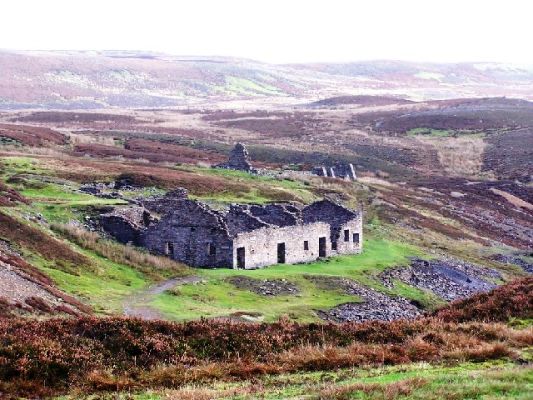 |
Northern Mine Research Society Registered Charity 326704 |
Surrender Mill
Reeth - NY 991999
The Surrender companyís Low and New mills grew increasingly dilapidated, but their replacement had to wait until after September 1839, when a new lease stipulated that the lessees should build a new mill and 500 yards (457 metres) of flue within two years. This was apparently done in 1841, when the mill accounts record that only 53.67 tons of lead, and no slag, were smelted.
The first flue ended at a chimney 470 metres from the mill but, some time after 1854, it was extended to a total length of 745 metres. Another chimney, shown on the 1854 O.S. sheet, 200 metres behind the mill may have been a condenser.
Apart from an entry in a list of smelting companies (Exors of G.W. Denys), published by the Mining Journal in 1882, no alternative has been found for Dr Raistrickís suggested closure date of 1880 for the Surrender mill.
The flue system of this mill, which is now a Scheduled Ancient Monument, has received particular attention. For example, Sallie Bassham examined it in some detail during a study of the environmental impact of lead smelting. She speculated on the possible use of a condenser and described the settlement pits etc which were used to recover lead fume. She also drew attention to two short, mined sections in an extension of the flue, dating from around 1866. The lower one is about 100 feet long and was made as part of the extension, whereas the upper one, which has a seven fathom deep shaft from surface, was probably an old working. A paper by Richard Smith and Richard Lamb, shows that no condenser was ever used on this flue, but discusses proposals to do so.
By late 1879 the AD Mining Company Ltd had begun selling its ore to other smelters, after first roasting some of it to increase its value. Surrender Mill closed in 1880 and its supply of peat was taken to the Old Gang Mill. The mineral lords continued to maintain the mill, but in September 1902, its roof timbers, slates, copings, doors and floor boards were sold at auction. In August 1909 the Stang & Cleasby Lead Mines Ltd paid £50 0s 0d for the millís 14 foot diameter wooden waterwheel.
Further information and references can be found in:
 |
Copyright © Paul C and licensed for reuse under this Creative Commons Licence |
The first flue ended at a chimney 470 metres from the mill but, some time after 1854, it was extended to a total length of 745 metres. Another chimney, shown on the 1854 O.S. sheet, 200 metres behind the mill may have been a condenser.
Apart from an entry in a list of smelting companies (Exors of G.W. Denys), published by the Mining Journal in 1882, no alternative has been found for Dr Raistrickís suggested closure date of 1880 for the Surrender mill.
The flue system of this mill, which is now a Scheduled Ancient Monument, has received particular attention. For example, Sallie Bassham examined it in some detail during a study of the environmental impact of lead smelting. She speculated on the possible use of a condenser and described the settlement pits etc which were used to recover lead fume. She also drew attention to two short, mined sections in an extension of the flue, dating from around 1866. The lower one is about 100 feet long and was made as part of the extension, whereas the upper one, which has a seven fathom deep shaft from surface, was probably an old working. A paper by Richard Smith and Richard Lamb, shows that no condenser was ever used on this flue, but discusses proposals to do so.
By late 1879 the AD Mining Company Ltd had begun selling its ore to other smelters, after first roasting some of it to increase its value. Surrender Mill closed in 1880 and its supply of peat was taken to the Old Gang Mill. The mineral lords continued to maintain the mill, but in September 1902, its roof timbers, slates, copings, doors and floor boards were sold at auction. In August 1909 the Stang & Cleasby Lead Mines Ltd paid £50 0s 0d for the millís 14 foot diameter wooden waterwheel.
Further information and references can be found in:
- Gill, M.C. Yorkshire Smelting Mills Part 1, Northern Mine Research Society Memoirs 1992, British Mining No 45, pp 111-150
- Gill, M.C. Yorkshire Smelting Mills Part 3, Northern Mine Research Society Memoirs 2000, British Mining No 67, pp 108-119